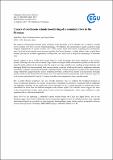Por favor, use este identificador para citar o enlazar a este item:
http://hdl.handle.net/10261/150610COMPARTIR / EXPORTAR:
 SHARE
BASE SHARE
BASE
|
|
| Visualizar otros formatos: MARC | Dublin Core | RDF | ORE | MODS | METS | DIDL | DATACITE | |

| Título: | 5 years of continuous seismic monitoring of a mountain river in the Pyrenees |
Autor: | Diaz, J. CSIC ORCID ; Sánchez-Pastor, Pilar CSIC ORCID ; Gallart Muset, Josep CSIC ORCID | Palabras clave: | seismic noise variations Pyrenees |
Fecha de publicación: | 2017 | Editor: | European Geosciences Union | Citación: | Geophysical Research Abstracts, 19: EGU2017-4605 (2017) | Resumen: | The analysis of background seismic noise variations in the proximity of river channels has revealed as a useful tool to monitor river flow, even for modest discharges. Nevertheless, this monitoring is usually carried on using temporal deployments of seismic stations. The CANF seismic broad-band station, acquiring data continuously since 2010 and located inside an old railway tunnel in the Central Pyrenees, at about 400 m of the Aragón River channel, provides an excellent opportunity to enlarge this view and present a long term monitoring of a mountain river. Seismic signals in the 2-10 Hz band clearly related to river discharges have been identified in the seismic records. Discharge increases due to rainfall, large storms resulting in floods and snowmelt periods can be discriminated from the analysis of the seismic data. Up to now, two large rainfall events resulting in large discharge and damaging floods have been recorded, both sharing similar properties which can be used to implement automatic procedures to identify seismically potentially damaging floods. Another natural process that can be characterized using continuouly acquired seismic data is mountain snowmelt, as this process results in characteristic discharge patterns which can be identified in the seismic data. The time occurrence and intensity of the snowmelt stages for each season can be identified and the 5 seasons available so far compared to detect possible trends The so-called fluvial seismology can also provide important clues to evaluate the beadload transport in rivers, an important parameter to evaluate erosion rates in mountain environments. Analyzing both the amplitude and frequency variations of the seismic data and its hysteresis cycles, it seems possible to estimate the relative contribution of water flow and bedload transport to the seismic signal. The available results suggest that most of the river-generated seismic signal seems related to bed load transportation, while water turbulence is only significant above a discharge thres.hold | URI: | http://hdl.handle.net/10261/150610 |
| Aparece en las colecciones: | (Geo3Bcn) Comunicaciones congresos |
Ficheros en este ítem:
| Fichero | Descripción | Tamaño | Formato | |
|---|---|---|---|---|
| Diaz_EGU2017-4605.pdf | 35,09 kB | Adobe PDF |  Visualizar/Abrir |
CORE Recommender
Page view(s)
285
checked on 17-abr-2024
Download(s)
84
checked on 17-abr-2024
Google ScholarTM
Check
Este item está licenciado bajo una Licencia Creative Commons

